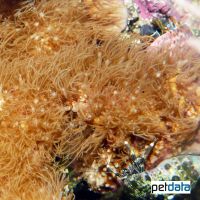Encrusting Gorgonian (Erythropodium caribaeorum)
| Encrusting Gorgonian Erythropodium caribaeorum | |
|---|---|
| Name | Encrusting Gorgonian |
| Name Lat. | Erythropodium caribaeorum |
| Family | Anthothelidae |
| Family lat. | Anthothelidae |
| Order | Soft Corals |
| Order lat. | Alcyonacea |
| Origin | Western Atlantic |
| Diet | Autotrophic, planktivore |
| pH | 8.1-8.4 |
| Hardness | 6-10 °KH |
| Lighting | Medium - high |
| Current | Moderate - strong |
| Behavior | Aggressive |
| Keeping | Solitary, colony |
| Care Level | Moderate |
| Life Span | N/A |
| Protection | No |
| Metric Units | |
| Size | < 60 cm |
| Temperature | 22-27 °C |
| Salinity | 33-36 ‰ |
| Aquarium | 180 l |
| US Units | |
| Size | < 24" |
| Temperature | 72-81 °F |
| Salinity | 1.020-1.025 sg |
| Aquarium | 50 gal |
Distribution and habitat
The range of Erythropodium caribaeorum is the tropical western Atlantic, where they are widely distributed from the Bahamas to the Caribbean, the Gulf of Mexico to Venezuela. They live mostly on inner reefs and in the shallow water of well flowed lagoons and often form large colonies.
Maintenance
They should be positioned in a location with moderate to high light intensity and moderate to strong alternating current
Only high-calcium, heavy metal-free substrates should be used as substrate. Filters, skimmers and heaters are necessary to ensure water quality, as well as pumps to simulate tides, swells and bottom currents. It is recommended that live stones be used to set up the aquarium. The bacteria living in the porous stones act as a biological filter. The lighting must correspond to the species-appropriate day-night rhythm of the animals
| Salinity: 33-36 ‰ | pH value: 8.1-8.4 |
| Carbonate hardness: 6-10 °KH | Nitrate content: 2-8 mg/l |
| calcium content: 400-450 mg/l | Nitrite content: 0.0-0.05 mg/l |
| Magnesium content: 1.250-1.350 mg/l | phosphate content: 0.01-0.1 mg/l |
Regular addition of trace elements, especially iodine and strontium, is recommended. For salinity, an average value should be aimed for, which may only vary slightly by +/- 0.5 ‰. Ammonia and ammonium must not be measurable. Special attention shall be paid to consistently good water quality and water values.
Diet
Zooxanthellae, which are unicellular symbiotic algae, live in their tissue and provide them with assimilation products of their photosynthesis (high light requirement). The zooxanthellae promote growth and provide additional food to the plankton and small particles collected from the water current. In addition to the food produced in the aquarium during fish feeding (mysis, krill, artemia, etc.), commercial food for lower animals in the form of phyto- and zooplankton, frozen or liquid, should be offered regularly
Regular and varied feeding promotes health and increases resistance.
Behaviour and compatibility
It is a fast growing, colony forming coral and can be well socialized with fish that do not consider it food. A sufficient distance (e.g. sandy area) must be kept to other corals so that it does not overgrow them.
Reproduction and breeding
Their asexual reproduction occurs through the formation of daughter colonies (budding). Reproduction by fragmentation is well possible. A suitable hard substrate is placed at the colony and after overgrowth the connection point to the mother colony is separated
Important
With unrestrained growth it can push back or overgrow other corals. It should therefore be isolated e.g. by a sandy area or prevented from uncontrolled spreading by comparatively aggressive corals
The additional illumination with actinic light (short-wave, violet-blue light) is very beneficial for its growth (zooxanthellae).
For the necessary uniform supply of calcium carbonate and magnesium, a calcium reactor and a magnesium metering pump are recommended.
If different species are kept together, care should be taken to ensure that fish and invertebrates match each other in terms of water quality and temperature requirements, as well as their social behavior, and that the setup meets the ecological needs of all species kept together. Newly introduced animals must be acclimated slowly to the water in the aquarium.
Further literature can be found in your pet store.
References
Text: petdata; Image: petdata
Source: KNOP (2013): Lexikon der Meeresaquaristik, Natur und Tier Verlag; ENGELMANN & LANGE (Hrsg.) 2011: Zootierhaltung - Tiere in menschlicher Obhut: Wirbellose, Verlag Harri Deutsch
